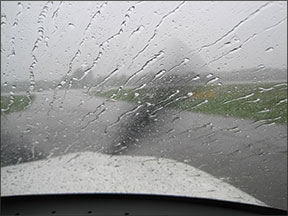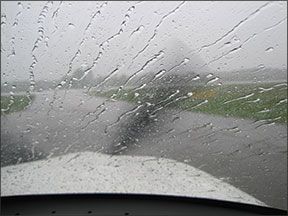Too often, instrument training can focus only on approaches, those procedures at the end of a flight allowing us to find a runway and land on it. But well before we’re cleared for an approach, we have to take off, climb to altitude and get through the en route system to someplace close to our destination. Sure, approaches are sexy, but other portions of an instrument flight are just as important. Take initial climb and departure, for instance, something at which pilots routinely fail.

288
It seems especially tragic: In the first minutes of a flight, when the airplane is barely off the ground during an IMC departure, it abruptly ends when an experienced pilot becomes disoriented, or the aircraft collides with terrain or an obstacle. How does this happen? What must we do to avoid a similar fate? To find out, we’ll look at a series of IFR departure crashes that occurred over a fairly short period of time and are summarized on the opposite page to see if there are any recurring themes that can teach us survival techniques. Can you find any commonalities between these fatal crashes? Our list is summarized in the sidebar on page 14, but let’s discuss them.
Low IFR
Aviation instructors and authors spend a lot of time suggesting pilots should not attempt a takeoff in low instrument conditions. We not arbitrarily recommend taking off only when conditions are such that you can reasonably expect to return to the departure airport after completing an instrument approach. The inference is that, if something goes wrong requiring you to make an immediate return, you’ll be able to get the aircraft down at the closest available airport, usually the one from which you just departed.
Interesting, though, that in each of the cited cases, all airplane systems seemed to be operating correctly until the point of impact. There was no apparent malfunction—except perhaps for the pilot—until the moment of impact. In other words, the fact the airplane could not return to the destination airport was irrelevant. In that regard, the ceiling might as well have been 500, 600 or (as it was in one of the cited crashes) 700 feet agl—seemingly as soon as the pilot entered the murk, a process began that led to each tragic end. Although the first three items on our list should give any pilot pause to reconsider departing, the fact that conditions were LIFR instead of merely IMC doesn’t play much of a part in what happened next.
The four remaining bullet points in our first commonalities list, however, are very telling. In all these cases, the pilot failed to establish and maintain a positive climb rate. In one case, the airplane descended well below field elevation into a valley before impacting an obstacle. In others, the airplane flew almost level until impact; in most the airplane descended into terrain as the pilot entered a turn.
The two final items on this list—failure to follow the cleared departure path, and failure to acknowledge a frequency change and/or (in most of the cases) report in on the departure frequency provide additional circumstantial evidence that the pilots were distracted. When no pre-impact anomalies are found during the investigation—true in all these events—what could cause this type of distraction?
Primarily, this stems from lack of preparation. If the pilot’s not ready for the departure procedure, something as simple as the absolutely predictable and expected handoff and frequency change very shortly after becoming airborne can start a chain of pilot-distraction events that ultimately can lull the pilot’s attention away from basic aircraft control at an altitude from which there is very little time to recover.
In their favor
It’s less common for pilots to consider what pilots had going for them up to the instant of impact, but these cases all share a number of things that we normally consider factors in avoiding fatal crashes. All of the airplanes were well equipped, although the SR22 pilot clearly did not understand how his autopilot worked.
The pilots all had copious time logged, including in make and model, and all exceeded the minimum instrument currency requirements—they were pilots we’d have considered to be low-risk in their aircraft, right up until impact. More than half of the cited crashes involve multiengine airplanes, and half of those were twin-engine turboprops. Isn’t improved safety in IMC considered to be a—perhaps the—major safety enhancement of multiengine aircraft, phenomenally more so when the powerplants are turbines?
Further, all these pilots were on positive IFR clearances for their departures (e.g., not trying to “pick up a clearance” in the air), and most were flying from tower-controlled airports. These are all supposed to be factors that substantially reduce the risk of flight in low IMC.
The point is that none of these factors operating in the pilot’s favor (not to mention their passengers’) made any difference to the outcomes on these sad events. Ultimately, it comes down to the pilot’s ability to manage simple attitude instrument flying during the very early stages of initial climb—the fact the airplane was a high-performance single, a twin or a turboprop as irrelevant and the pilot may have well have been flying a simple training airplane for all the good aircraft type and capability did.
This brings us to our last point: takeoff and initial climb carries with it the significant additional risk of being the phase of flight when the airplane, its engine(s) and systems may have passed preflight inspection and a ground check, but they’ve not yet proven themselves under high stress. Despite your best intentions, you may not find until you’re airborne that you’ve set the wrong departure frequency or forgotten to turn on the transponder or any number of other minor but distracting things. If it’s the first flight of the day, you’ve not yet demonstrated you’re on top of your flying game. If it’s your second or third or fourth leg of the day, or it’s night or you are making the flight after a long day at the end of a long week at the office, you don’t know your fatigue state. In addition to being a low-altitude/high angle of attack phase of flight, takeoff and initial climb is the phase of flight with the most unknowns.
10 Mitigations
So what can we learn from these surprisingly similar events that will help us avoid being added to the list? Here’s my list of the 10 things we can do mitigate departure accidents like these, to be accomplished before even taxiing to the runway.
1. Know the proper pitch attitudes, power settings and resulting expected performance for initial climb. You shouldn’t have to guess at how far to pull the nose up, or how much bank is required for a standard-rate turn at climb speed. Basic attitude flying is primary; the GPS and other needles only tell you which direction to fly the airplane. Attitude flying needs to be instinctive.
2. If you’re not thoroughly familiar with the avionics and autopilot in the specific airplane you’re flying, get some instruction from someone who is before you bet your life on its operation. From your training and practice, you should know what to do when an anomaly occurs in a high-workload phase of flight.
3. Be meticulous about your pre-flight inspection, startup and (especially) the before-takeoff checklist. Flows and crosschecks are great, but there’s no excuse for not using a printed checklist to confirm you have the airplane in its proper configuration for an IFR takeoff.
4. As part of your before-takeoff checks, run through the avionics and make sure they’re set for departure. Everyone has their own preference, but this is what works for me:
I set my #1 radio for the CTAF or tower (as appropriate) as soon as I’m ready to go. I preset the departure frequency in the standby on the #1 comm (virtually everybody has flip-flop frequency radios now).
I also tune departure in the active slot of the #2 radio. Now, all I have to do when handed off is to flip the #1 frequency and, if that radio should choose that time to fail, a quick flip of the audio panel to transmit on the #2 comm makes departure my active radio.
Program the GPS before leaving the run-up area. Never let yourself take off thinking you’ll enter the waypoint or the flight plan once you’re airborne. Use the VOR side of your panel to set any frequencies/radials you may need, either as part of your departure routing or to help you set up for the approach back into the departure airport.
Don’t forget the reminder aids: heading bugs, altitude bugs, airspeed bugs, altitude preselects, anything that will give you a positive indication of where to point the airplane. Set and engage the flight director, if equipped.
5. Brief your departure, even if only to yourself. I find it helps to say it out loud. For example, “I’m cleared for takeoff. Fly runway heading to 2000 feet, then left turn to 150 to intercept the VOR radial set in the #2, then up to 3000 feet for now.” Brief the altitude, heading, route and radio frequency, in addition to your actions in the event of an anomaly or emergency during or just after takeoff.
6. If you have a flight director, program it and use it—after getting enough practice to be very familiar with it. Unless you keep its modes set properly, it will indicate attitudes and headings different from what you need. This makes a flight director a strong source of its own distractions.
7. Delay engaging the autopilot until you’ve reached at least 1000 feet agl and you’ve configured the airplane for cruise climb. You don’t know how the autopilot will respond until it’s engaged, and close to the ground at a high angle of attack is not the time to find out something’s wrong. Stay current enough at hand-flying in IMC to be able to confidently depart into the clouds.
8. Do a well-practiced takeoff final items check. I use the mnemonic FLATS:
F—Flaps set, cowl flaps open
L—Doors and windows Latched; Lights as required
A—Avionics activated (transponder)
T—Trim set, takeoff Time recorded
S—Switches, notably lights, ice protection, auxiliary fuel pump and/or air-conditioning systems, as desired or required.
9. Run a sterile cockpit during departure until you are at least 1000 feet agl and have settled on your climb heading or route. Some of us don’t settle down until we’re talking to Center and cleared to our cruising altitude. Delay any actions not immediately necessary to assure a safe transition to climb. Use your intercom’s pilot isolation switch, or direct your passengers to remain quiet unless they see an obvious safety issue.
10. Remember a bad day can happen to anyone, regardless of the aircraft, its equipment or your experience. Reread and incorporate steps 1-9 above into your standard operating procedures for an instrument departure.
On Your Own
I haven’t even touched on published departure procedures, which pilots can ignore or misinterpret. One has to wonder if approaches get so much attention in our training that we forget an flying one involves a relatively light, decelerating aircraft while a takeoff means we’re at its heaviest, and accelerating. Why is it so hard to establish a climb and fly a certain heading?
I’d still recommend against departing in “100-foot/sky obscured, visibility 1/8 mile in fog” conditions. As a private operator, however, you have the option of doing so if you are comfortable with the risk. But know that you’re on your own, and you need to make it count.




